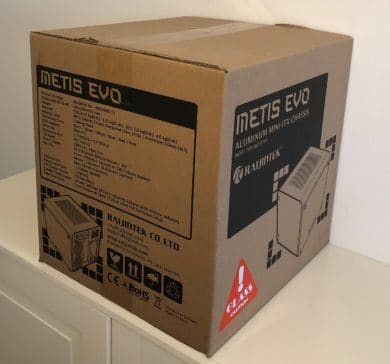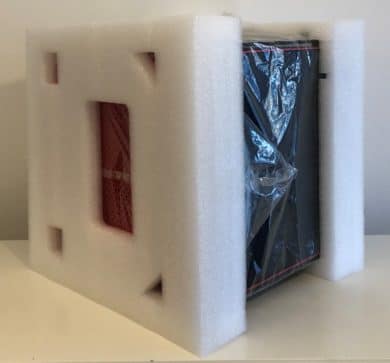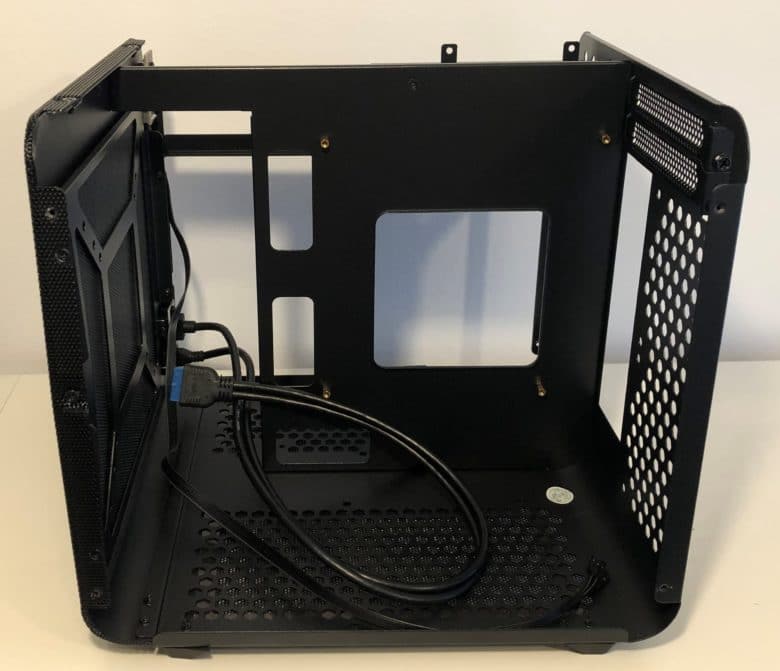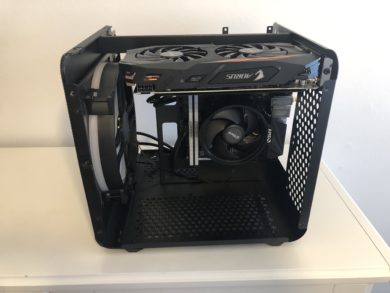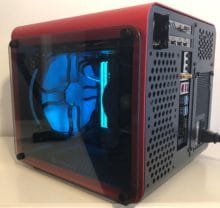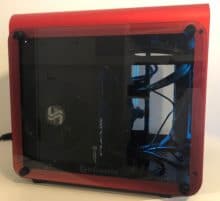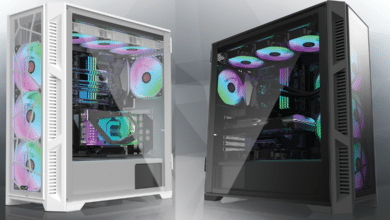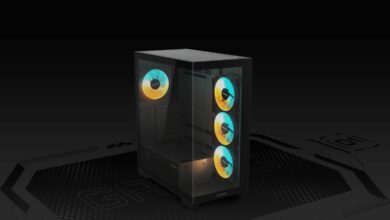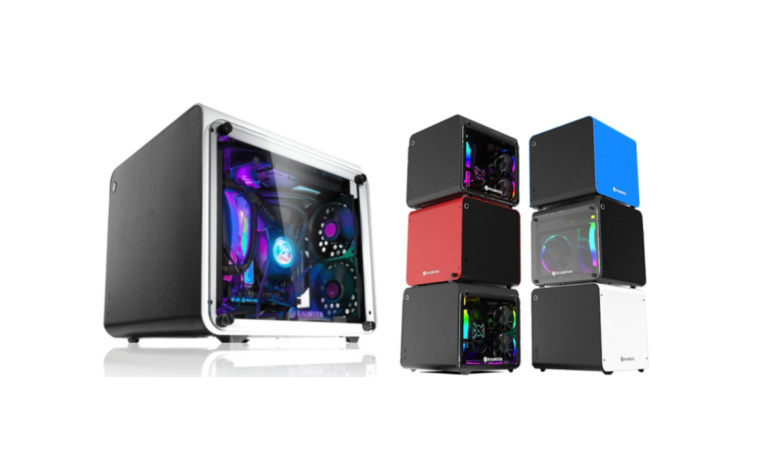
There it is at last, the further development of the popular Mini-ITX case from Raijintek.
The Raijintek METIS EVO.
This housing comes in two versions. One is the METIS EVO TG, which is equipped with tempered glass panels on the right and left side of the case to admire the full splendour of the interior. The second version of the METIS EVO AL comes as an “aluminium cube” and has only a few ventilation slots on the left and right side of the case. However, if you think that the Mini-ITX case already has a heat problem, you shouldn’t stick your head too far into the case, otherwise you’ll catch a cold with the huge 200 mm, front-mounted fan. The beating is located behind a fine mesh grid, which puts up a fight with your sweaty hardware inside. The METIS EVO TG is also available in the colors Black*, White*, Red*, Silver* and Blue*. Furthermore there is the alternative variant, the Raijintek METIS EVO AL, in the colours Black*, White* and Silver*.
| Model | Raijintek METIS EVO TG/AL |
| Type | mini-housing |
| Dimensions | WxHxD: 293x263x290 mm |
| Weight | 4.35 kg |
| Material | steel (sheet metal), glass, plastic |
| Color | black, red |
| Connections | I/O front panel: 1 x Type C USB + 1 x USB3.0 |
| Ventilation |
|
| CPU cooler | maximum height: 135 mm |
| Graphics card | Length maximum: 280 mm |
| Price | METIS EVO TG: 134,90€ (colour does not matter)
METIS EVO AL: 134,90 € (Colour does not matter) |
| Hard drives | 2 × 2.5″ + 2 × 3.5″ |
| ANY SPECIAL TALENT? | Sandblasted aluminium housing
Power supply compatibility: ATX/ Adapter for SFX Complete black inner coating |
Scope of delivery
The case comes in a square package and is securely stowed in the box with two polystyrene spacers. The housing is in a protective foil. The glass windows are additionally covered with a protective film. Included in delivery are an adapter plate for SFX power supplies, screws (for mainboard and case) and cable ties.
Exactly looked at – outside
If you take the case out of the cardboard and its protective foils, you will immediately notice that the case makes a very high-quality first impression. The second impression confirms the first one. The case has a high quality material. It only consists of sheet metal components, which are very well manufactured and are very well presented in the Mini-ITX case. However, the relatively small case weighs in at a respectable 4.35 kg. The glass windows do not rest on the case, so that air can flow very well into the case.
The version of the Raijintek Metis EVO TG tested here has a red anodized housing wall. The front panel consists of a small I/O panel with USB C and USB 3.0 ports. The power button is located in the upper left corner. The entire front consists of a mesh grid behind which a case fan of up to 200 mm can be installed. This front design allows a lot of air to enter the case to regulate the heat inside the case. The whole “spectacle” is then visible on the back. Due to the design, the graphics card is installed horizontally in the upper part of the case. Below this, up to 2 x 90 mm case fans can be integrated. Furthermore the connection possibilities (I/O panel) for the mainboard are located here. On the right side you can see the installation possibility for the ATX or SFX power supply. Above it are the 2 x 3.5″ mounting bays for HDD hard disks. These are not decouplable. The case stands on four rubber feet to decouple vibrations on the table.
Exactly looked at – inside
From the outside already a splendour, from the inside likewise a piece of jewellery. The case looks very tidy and well thought-out in terms of hardware layout. The case is completely covered with dust filters on the outside.
Here you can clearly see the installation options for the two 3.5-inch hard disks – the black cuboid. A 2.5″ hard disk can be installed above the black cuboid. Either a 90 mm fan or another 2.5″ hard disk can be mounted in the floor space. However, a combination of fan and hard disk in the floor space is not possible. Furthermore you can see the connectors for the front I/O panel in the left picture on the lower right side. A cross brace helps to stabilize the case. Unfortunately, as already mentioned, the 3.5″ bays can’t be decoupled. Also here you can see the large case front for a 200 mm fan.
On the right side of the case you can clearly see the intended mounting surface for the mainboard. A 90 mm fan can be installed in the floor space. However, it is not possible to exchange this fan for a hard disk if necessary. On the rear side there is also the possibility to install two 90 mm fans. Due to the mainboard position, a CPU cooler with a height of up to 135 mm can be selected here. The graphics card is installed above the mainboard. This can be up to 280 mm long and may only occupy two slots. An AiO water cooling system can also be installed in the front panel in addition to a case fan. However, this must not exceed a maximum height of 35 mm, as otherwise it could collide with the mainboard. The cables from the I/O-panel of the front panel are long enough to mount it comfortably to the mainboard.
Look closely – Hardware
Now that we have looked at the case in enough detail, it’s time for a little taste. Because you all will want to know how the hardware looks like inside the case… Let’s go!
The test system consists of the following components:
As already mentioned at the beginning, a case fan of up to 200 mm fits into the front of this case. Of course I don’t want to spoil this picture for you! So your hardware will definitely not get too warm inside.
This fan is screwed to an additional mounting plate built into the housing. This mounting plate is modular. Very comfortable to integrate case fans in this way. The installation of the hardware described here was no problem and very easy and fast to realize. The graphics card sucks the air through the case cover. Since this cover is provided with a very generous hole pattern, the graphics card gets enough and sufficient fresh air. The desired ATX power supply can be mounted in two directions through the eight mounting holes in the mounting bezel. Thanks to the metal bracket built into the case bottom, the power supply is also supported and relieved.
When assembling hardware with the case the following view results:
Due to the large front fan, you immediately notice the constant airflow from the front of the case to the back through the case, whereby the warm air is transported away very well. On the left side of the case, only the power supply unit and a bit of cable tangle are visible. Nevertheless, the case interior still looks very “clean” and well thought-out.
Conclusion
If you want to build a Mini-ITX system, the new METIS EVO series of cases from Raijintek is the perfect choice. The case shows a very good processing. Sophisticated and tidy, it presents the user with a compact performance package, both when empty and when installed. Due to the two built-in glass panels, which are combined with a continuous mesh front, the METIS EVO TG is very well suited for the construction of a compact and light ITX-Mod. Although this is an ITX system, the dimensions of the interior allow the use of powerful hardware components. By air and/or water cooling there are almost no limits. If you have now also got desire to build up ITX-Casemod in this way then you will hardly be able to avoid the Raijintek Metis Evo.
Raijintek Metis Evo
Workmanship
Structure
Features
Dampening
Cooling
Value for money
95/100
Sophisticated and high-quality case!
